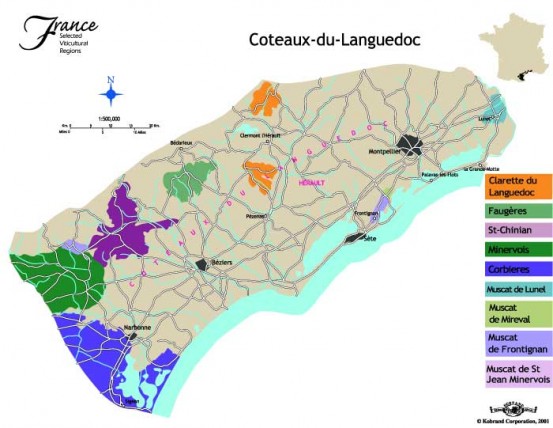The Languedoc is one of the oldest settled areas of France. The Greeks were early traders (7th century BC) bringing the original grape vines to the area. A conflict between Celtic tribes (who had been migrating over time) and the local inhabitants of Marseille prompted a call to the Romans to settle the dispute. They arrived around 100 BC and ruled for 500 years (careful what you ask for!!??). Unlike the Greeks who were traders, the Romans moved to the area as colonists and finally residents. The period of Roman oversight was one of prosperity and peace. The agriculture of the region thrived and wine estates were wide spread, often extensive and wealthy households. By early 400 AD the Visigoths started their invasive sweep southward after noting that the Romans were losing a hold on their vast territories. Once the administration of commerce broke down with the scattered fiefdoms and territories so went the prosperity. The once wealthy wine industry disintegrated as chaos became the norm.
The early 20th century witnessed a short burst of prosperity return to the Languedoc. The phylloxera louse was “gifted” by well meaning botanists who sent grape “parts” to their colleagues in France. Up to 40% of the French vineyards failed over a 15 year period of time. Once the cause was discovered, and after other proposed solutions were tried, French scion wood was grafted onto resistant American rootstock. (This is not quite that simple but here is not the place for a full length dissertation on phylloxera…,besides, it has no doubt been done!). Because the pestilence started in the Languedoc they were the first to replant and had a head start on other grape growing regions of France. Once Bordeaux, Burgundy, Champagne, etc. were replanted and thriving the attention of the wine world moved away from the Languedoc.
Neither economic standard has yet to be achieved again, although from what I see now I think that the Languedoc and the Roussillon will be the wine story of the 21st century. The sunny weather and proximately to the seas (both Atlantic and Mediterranean) allow for long leisurely ripening. The harvest here is just finishing up. Mornings are cool and crisp. The sun warms the afternoons to a lovely 23 degrees. Add to this unspoiled beauty, diversity of food and wine and a variety of locations to fulfill individual likes and dislikes.
Sun and food are always on my mind, but a primary point of my research continues to be the search for that perfect piece of ground that has nurtured old vines for decades and sparingly offers bunches of grenache and possibly carignan fit for loving vinification and bottling. As my experience and knowledge grow I continue to work on the current OVG project and am now working on finding a location in the Languedoc for winemaking 2011. The viticultural area referred to as the Languedoc is very large and this search will take some time (quelle damage!). I am taking the sub-regions one at a time.





No comments yet.
Leave a comment